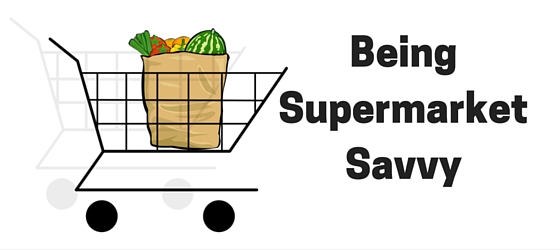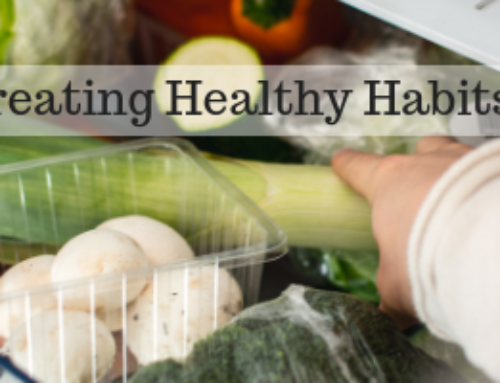Odds are, the majority of the food you eat on a weekly basis comes from the grocery store. Believe me, however, when I say that your health is not the first concern of the food industry that creates most of the food products for sale. Your health is in your hands, so here are some tips to take with you to the grocery store the next time you shop to ensure you are choosing the healthiest items.
Make a grocery list and do some meal planning. Some people give the excuse of “not having enough time” as the reason for poor eating habits. But I would argue that you can actually save time by planning ahead, shopping with a strategy, and doing some food prep for your busy week ahead. First, get into the habit of making a “running” grocery list as you go through the week, and add items as needed. It can be instrumental in keeping your kitchen organized and stocked. Secondly, choose a day to plan out the next week’s meals or at least some of them. Have fun with this; try not to think of it as a chore. Make it easy by focusing on basic recipes that are healthy favorites. I love experimenting with spice blends that I can simply dust on chicken and pop in the oven – no recipe required. If you live in Seattle, Market Spice, is a great place to get inspiration and you can often find their spice blends in the spice bulk section at local grocers. Also, make garlic, ginger, and fresh herbs your friend. These seasonings are not only good for you, but flavor powerhouses.
Shop the periphery of the market. I know you have probably heard this one before, but it is worth repeating. This is where the whole food selections will be located. For the most part, the inside aisles contain packaged foods that can have a shelf life of several months. Exceptions of course include items like canned fish, olives, beans, and some frozen goods which leads to the next tip.
Don’t forget the freezer section. This is one inside aisle that is worth investigating. Frozen fruit and veggies can be especially helpful at times. They are picked at the peak of ripeness so frozen produce is exceptionally nutritious. Frozen fruit is great for smoothies, and you can even thaw out berries to put on top of plain Greek yogurt. A ray of sunshine in the dead of winter when you don’t want to buy berries from south of the equator. Don’t forget veggies like spinach, Brussel sprouts, or cubed butternut squash which can be handy to have on hand when your produce drawer is running low.
Spend some time in the produce section. Fill your basket with several different kinds of fruits and vegetables, the more color the better. Try to purchase what is locally grown and in season if possible. Also, you can augment your grocery store purchases with produce from the farmer’s market, especially in the warmer months. A good goal to shoot for is filling half of your plate with veggies. Try to do this at both lunch and dinner. Don’t forget to eat some raw vegetables each day.
Choose organic or free range animal products when possible. Animals are higher on the food chain, thus they eat and absorb a lot over their lifetime, including pesticide residues from grains. Conventionally raised animals are often given antibiotics and even steroids to promote growth. Remember that meat, milk, and eggs are only as good as the lives of the animals that gave them to us. If an animal lived in a confined area and was fed conventional grains and fattened with hormones and antibiotics, how good do you think it’s going to be for the person who eats it?
If it has a label, read it. Label reading is an excellent habit to get into, and one that will teach you the most about any packaged food you purchase. Remember that the ingredients label is as important, if not more important than reading the Nutrition Facts Label. It will tell you the quality of the food that was used to make the product. If you want to learn more about food ingredients and which give the most cause for concern, then check out the Environmental Working Group’s Food Score Page where they give ratings on all ingredients that might make their way into packaged foods. A good rule of thumb though is to choose products with a small amount of ingredients. It just makes sense.
Look at the sugar content. It’s listed under total carbohydrates in the Nutrition Facts Label. Remember that 4 ½ grams of sugar equals one teaspoon, if the serving of food has over 9 grams of sugar, you may need to rethink your purchase.
Look at the fiber content. This will be found in the Nutrition Facts Label in plant based foods. The more the better. In general, for every 15 grams of carbohydrate, there should be 3 grams of fiber or more.
Look for “hydrogenated oil” or “partially hydrogenated oil.” You will see these items in the ingredients label. Avoid anything that has it. Foods that contain these oils are mainly packaged foods like crackers, cookies, candy, etc. Partially hydrogenated oils contain trans fats, which are very bad for your health, and have been implicated in heart disease. Common foods that contain these oils include commercial peanut butters and microwave popcorn. Read ingredient labels to find out if the food has these damaged fats.
Steer clear of refined oils. Refined vegetable oils, like corn or soybean oil, are bad for you. They have usually undergone an extraction process with solvents like hexane that can be very damaging to the oil. Also, they contain fats that promote inflammation. Purchasing and consuming high quality oils is one of the most important nutritional decisions you can make for yourself. High quality oils include extra virgin olive oil, avocado oil, macadamia nut oil and coconut oil.
I hope you find these tips useful. If you live in Seattle, please let me know if you would like to do a grocery store tour together. I will often meet my clients at the store, where we get in front of the foods they buy, and decipher the nutritional quality, as well as find foods that are best for their specific health concerns.
As always, if you enjoyed this blog post, please share with family and friends!







